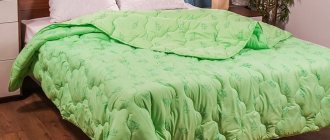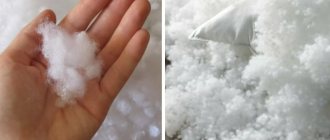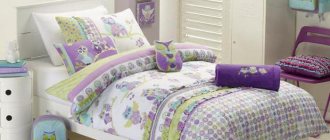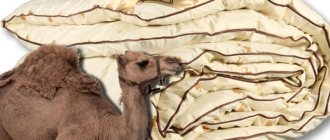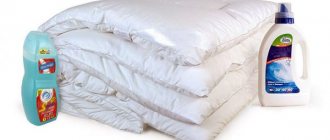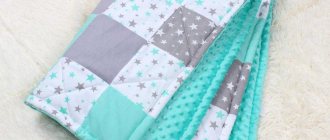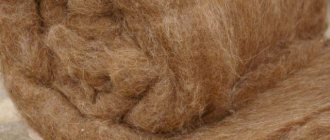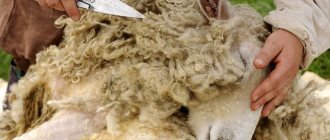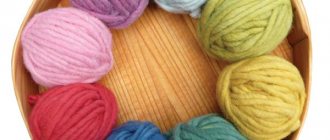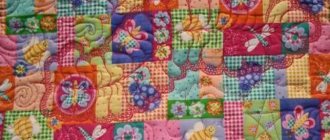Today, sheep wool filler is one of the most popular. Since ancient times, people have used animal wool for household purposes.
Wool bedding has a high level of comfort. Merino wool (a breed of sheep) is used as filling; they are bred for this purpose in Australia and China. Wool, although it wears out faster than synthetic filler, does not accumulate static electricity and does not contain toxic substances.
Making a pillow with dog hair
My hobby is dog hair. Clean, combed dog fluff is soft, warm, airy, fluffy, weightless, elastic! The idea arose to sew a pillow with this material. I searched the Internet, but unfortunately, I couldn’t find anything on dog pillows. So, let's experiment! 
There are a lot of questions floating around: maybe the pillow quickly falls off when used? Or will it give you a headache? Or is it too hot to sleep on? What if you experience an unpleasant odor or an allergy? Or will there be mites and moths?
In this work, I used Samoyed wool as a pillow filler.
The coats of different breeds are very different from each other. I’ll explain why the Samoyed was chosen for the pillow:
- The Samoyed's coat is snow-white (I associate it with cleanliness).
- Samoyed fur is odorless.
- The Samoyed's coat is easy to wash; it can withstand spinning in a washing machine (a very important advantage over other dogs, which fall into felt boots from such treatment).
- The Samoyed's coat does not have tangles; the combed coat is a fluffy cloud, similar to a portion of cotton candy.
If you have other wool in your supplies, you can experiment with that too.
This is what combed out, caked dirty wool looks like. Let me clarify, there is no smell!
Place the wool in mesh laundry bags.
510 g of combed show dog hair into 2 bags, approximately 250 g in each. I think this amount is enough for one pillow.
Let's start washing. In a basin of slightly hot water, about 50°, dissolve some detergent for washing wool (can be washed with shampoo). Samoyed wool can withstand higher temperatures without matting.
We lower our supplies and leave them to soak for a day.
Be prepared for the water to take on this color.
Since the pillow will be stuffed with wool, and we will sleep on it face down, we don’t waste time on washing. I kept the wool in the soapy mixture for three days, periodically changing the water, rinsing and re-soaking. On the third day, the water has cleared, which means it’s time to move on to drying (to avoid blockages in the pipe, use a mesh to catch hairs).
Samoyed wool is good because it can withstand spinning in the washing machine. This operation will significantly reduce the drying time in the future.
Wringed it out and left it to dry for 3-4 days. As you walk past the dryer, you can rub the wool, fluffing up any clumps that have formed.
Previously, I had to dry my Samoyed's fur on a radiator. Dries quickly, does not mat (this information applies specifically to the Samoyed, other wool can behave unpredictably, you need to try everything on a small piece). The wool is dry. Out of curiosity, we'll hook her up again. 455g clean versus 510g dirty. And this is not permanent weight loss. After combing, another part will come off.
Now the fur needs to be combed. After washing, everything fell into lumps that can be easily fluffed up with your hands.
Carder speeds up the process. This is a carding machine, it can be mechanical or electric, you can also use manual combs, the ones used to comb dogs.
Here is a photo of the debris that spilled out of the wool after carding. In addition, the tonnage was gone: ununtangable tangles, cut, dirty stuck together strands.
At the exit from the carder we have this fluffy mattress.
For comparison: washed and combed wool.
We roll all the mattresses into rolls.
We sew a pillowcase - a rectangular piece of thick fabric, sew it on three sides, and stuff it with wool through the fourth. We sew carefully, steam the seams with an iron.
We stretch the woolen mattresses to the size of the pillowcase. In the 1st photo there is a roll, in the 2nd photo there is an unrolled roll, in the 3rd photo there is a stretched mattress to the size of the pillowcase.
The height of the resulting packing.
We place the wool in the pillowcase in layers one at a time, straighten it and fill the corners.
We sew it up with a hidden seam (you can sew a zipper so that in the future you can quickly unzip it from time to time and see if there are any moths).
The pillow is ready. I'll start using it this evening.
I’ll write in the comments what will happen to the pillow during the year. If you also have such a pillow, please share your impressions.
Thank you for your time. Best regards, Natalia 
Peculiarities
Pillow filling is made from merino wool. This is a breed of sheep that is bred in Australia, China and Kyrgyzstan. Their fleece is soft and resilient, which is why it is an ideal material for pillows. Since it is an organic material, it has a number of features. It wears out faster than synthetics, but does not become electrified and does not contain toxic substances. This material requires more careful care if you want the product to be used for as long as possible.
Wool as a material is attractive due to its availability. It is not a scarce material. In addition, although it is difficult to obtain, it is a long-established process. The sheep are shorn, and the wool is laid out on a flat surface, straightened, shaken and unusable pieces are removed. Then it is thoroughly washed, combed and treated with special protective agents.
This material has been known for a long time as a filling for pillows; it has many advantages.
Advantages of camel and sheep wool pillows
- Light weight. The lightness of such material is comparable to the weight of bird down. From the outside it may seem that the pillow will be very heavy, but in practice it is quite the opposite.
Claimed properties:
- Excellent hygroscopicity. Although it is believed that wool almost instantly absorbs and evaporates up to 35% of incoming moisture, pillowcases made of bamboo, or the same flax, remove unnecessary water much better. For those who are even more demanding of hygroscopicity, we can recommend that you use special pillowcases.
- Therapeutic healing qualities. The substances indicated in the filler composition raise doubts about the veracity of their medicinal properties. The same lanolin, previously contained in wool and responsible for some of the medical properties, practically disappears even at the stage of preparation of raw materials, remaining in the structure of the filler in very small quantities. Moreover, it will not pass through the pillowcase in significant quantities.
Disadvantages of camel and sheep wool pillows
Such a product has almost as many disadvantages as advantages, which makes the advisability of purchasing such a pillow an exclusively situational issue.
- Potential allergenicity. Wool is a suitable habitat for ticks and other microorganisms. Before buying a pillow, doctors advise doing a test for individual intolerance, and also strongly advise against purchasing products for those (in particular children) who are intolerant to lanolin.
- Weak support. If you have neck diseases or problems with the musculoskeletal system (even in the initial stages of development), then such pillows are definitely not suitable, especially in the case of a child. Woolen products hold their original working shape very mediocrely.
Pillow filled with wool - Difficult care. This item must be regularly ventilated and treated exclusively by dry cleaning. Only regular systematic care will prevent the appearance of various types of pathogens.
- Manufacturers of such pillows often present information on the packaging in such a way that one might think that there is a lot of wool fiber and it has special properties. Such manufacturers are not conscientious and do not care about their reputation. Therefore, there is a possibility that the synthetic filler in such a pillow will be of low quality, including from recycled materials. Similar cases can be found in reviews.
- Unlike loose fillers such as feathers, buckwheat, granules, a wool pillow is more monolithic. You can’t give it a shape, you can hardly adjust it, and you can’t bend it to yourself during sleep. If your baby sleeps on their side or is a bit of an odd sleeper, it may not be suitable.
- High price due to the loud name.
Benefits of sheep wool pillows.
Despite the presence of numerous artificial materials that are created on the basis of high technology, sheep wool has numerous advantages.
- Healing characteristics . Natural wool contains an increased amount of animal wax lanolin, which can be the basis for cosmetic products and medicinal ointments. Lanolin can heat up from human heat, after which it can be absorbed into the skin and have a beneficial effect on the body. This property of the material is actively used to improve overall health, because the natural healing properties of sheep wool can be manifested in numerous situations.
- Minimum level of thermal conductivity . A person is protected from overheating and hypothermia during sleep. Initially, shepherds were able to discover this useful quality of sheep wool, because they prefer felt cloaks and sheepskin hats at any time of the year. In order for the optimal temperature to be maintained, the wool must be in contact with the human body.
- High level of breathability . Wool can successfully “breathe” because it has crimped natural fibers. This air circulation is beneficial even during sleep.
- Sheep wool is a hygroscopic material that can successfully absorb up to 35% of moisture relative to personal weight. Although the liquid is absorbed, the material may remain completely dry to the touch.
Customer reviews: advantages and disadvantages
- Thermoregulation. They retain heat well and protect from overheating in hot weather;
- Hygroscopicity. They do not retain moisture, quickly absorb and evaporate;
- Air exchange. Air circulates freely between the fibers;
- Light weight. Pillows made of sheep wool are 2 times lighter;
- Antistatic effect. Not electrified;
- The service life is 3-5 years with careful care.
- Gradually they fall off and lose their shape;
- Sometimes owners in reviews note prickliness, probably the wool was poorly processed;
- Not suitable for those who are allergic to wool;
- Some models are too expensive;
- They require gentle and complex care.
